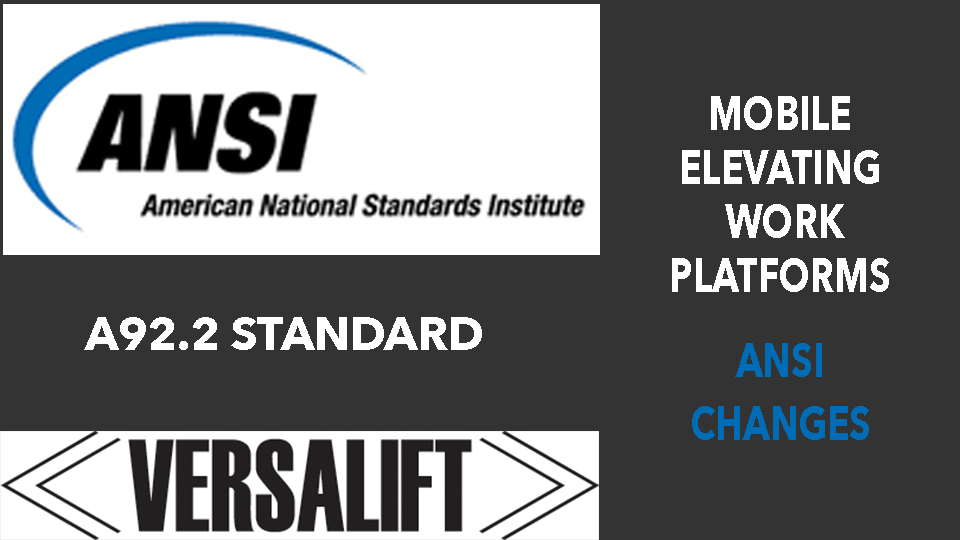Mobile Elevating Work Platforms MEWPS – ANSI Standards Promote Safety & Competitiveness
“Mobile Elevating Work Platform,” or MEWPS, is terminology being used by ANSI to describe some Aerial Work Platforms in its ANSI A92.2 Standards. ANSI, which is the American National Standards Institute, provides a set of standards for all American manufacturers and producers, and this includes standards that directly impact the design, calculation, safety and testing requirements for Versalift. ANSI standards continue to evolve – the most recent update for Aerial Work Platforms was in 2015, and manufacturers are looking forward to the next major update for A92.2 standards, which is in 2021. It was in 2015 that ANSI adopted the term of Mobile Elevating Work Platform, or MEWP.
Mobile Elevating Work Platform does not refer to all bucket trucks, vehicle-mounted aerial lifts and boom trucks. Rather, it is a term that applies to some equipment, including some bridge inspection units and self-propelled aerial lifts. Around the world, the whole category is often referred to as Aerial Platforms, Mobile Elevating Work Platforms and High Reach Platforms. ANSI’s shift in terminology is part of a broader move toward making American manufacturing more available and competitive within the global market. The terminology that people around the world use to describe Aerial Lifts, Bucket Trucks, Aerial Work Platforms and Mobile Elevating Work Platforms has not, to this point, been aligned.
Using the term “Mobile Elevating Work Platform,” ANSI is more closely aligning North American standards with the rest of the world. This will help to make American manufacturers stronger and more globally competitive.
Mobile Elevating Work Platforms and ANSI
According to the ANSI website, the American National Standards Institute “oversees the creation, promulgation and use of thousands of norms and guidelines that directly impact businesses in nearly every sector: from acoustical devices to construction equipment, from dairy and livestock production to energy distribution, and many more.” Some new A92.2 standards will go into effect in December of 2019. When they do, their impact will be felt in three major categories. These categories are:
-
A92.20-2018: Design, Calculations, Safety Requirements, and Test Methods for mobile elevating work platforms (MEWPs)
-
A92.22-2018: Safe Use of MEWPs
-
A92.24-2018: Training Requirements for the Use, Operation, Inspection, Testing and Maintenance of MEWPs
ANSI is not a regulatory body, and its standards are not, by themselves, enforced. However, OSHA will often adopt ANSI standards and make them law. Most manufacturers completely abide by ANSI recommendations in order to be fully compliant with the best design, safety and training guidelines available. In the case of all new Versalift equipment, each vehicle-mounted aerial lift comes with its own operations manual, which includes complete instructions for safe operation of the unit, including a daily inspection checklist and a review of every safety decal and operator’s warning on the entire vehicle.
What Is A Mobile Elevating Work Platform?
Mobile elevating work platforms are bucket trucks. Formerly known as Aerial Work Platforms, they are either aerial lifts or scissor lifts. Often referred to as MEWP, ‘mobile elevating work platform’ is the formal category of equipment that Versalift primarily manufactures to safely enable linemen and other technicians to gain access to overhead networks of utility and telecommunications infrastructure.
Contact Versalift Sales Department
Mobile elevating work platform options and upfits are very important to the people who use them. Each piece of equipment differs slightly, and hydraulic systems are mounted onto vehicles per fleet specifications. Vehicle mounted work platforms are much more useful as they do not require additional vehicles or resources to operate. Other mobile platforms are not vehicle mounted and therefore less costly to purchase. In these cases, MEWPs can be maneuvered and operated by one person, through upper controls that are mounted at the platform. These vehicles are not legally allowed to drive on any roads and must be transported to and from the worksite.
MEWPs – A short partial list of recent safety and design feature recommendations offered to manufacturers from OSHA
- Load and tilt sensing
- Stability test for pneumatic tires
- Wind force requirements for outdoor use
- Toe-boards on all platform areas
- Non-flexible MEWP lift entrance gates
- Taller platform railings
- Sustained involuntary operation controls
Safety recommendations are made and they help to provide direction to the engineers, who are working to comply and innovate to keep safe the technicians who work at the platform. Ultimately, it is the responsibility of every manufacturer to deliver a safe and reliable piece of equipment to the end user. Safe operation starts with manufacturing durable, reliable and safe equipment, and it continues with the training and preparation of linemen, who are certified by their employers to operate equipment.
Safe operation starts with manufacturing durable, reliable and safe equipment, and it continues with the training and preparation of linemen, who are certified by their employers to operate equipment.
Contact Versalift Sales Department
Mobile Elevating Work Platform is Formal Terminology
“Mobile Elevating Work Platform” is relatively new terminology for the American market, but the expertise and innovation of American manufacturers will carry on. Versalift’s Senior Vice President of Engineering, James Christian, has been an ANSI board member for over a decade. As the engineer responsible for advancements like the first articulated telescopic aerial lift and Versalift’s TruGuard™ Safety System, Mr. Christian is confident that the changes will help reduce confusion and increase competitiveness. Versalift has been working to remain in compliance, integrating the changes into some of Versalift’s design specifications. There will be several interesting changes, including specific warnings about equipment misuse, stated limits on working in hazardous environmental conditions and stability requirements for high wind conditions among others.
No matter how our products are named or classified, we are proud of the fact that Versalift equipment remains the safest and most reliable brand of vehicle-mounted aerial lifts in the industry. At Versalift, our goal is to continually improve our products and services, and to deliver our world-class to more fleets, contractors and governments around North America and the world. For more information, please feel free to reach out to your distributor, or contact us directly with any questions.

